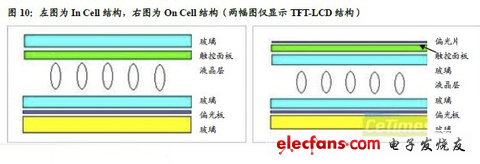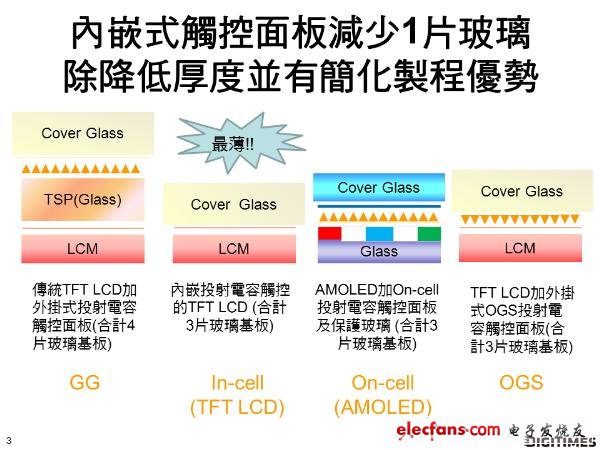At present, there are several development directions in the field of touch screens: OGS solutions led by the original touch screen manufacturers, and On Cell and In Cell technology solutions led by panel manufacturers.
At present, more powerful display panel manufacturers tend to promote On-Cell or In-Cell solutions. The main reason is that they have display screen production capacity, that is, they tend to make touch layers on the display screen; and touch module manufacturers or upstream materials Manufacturers tend to OGS, that is to make the touch layer on the protective glass, the main reason is to have strong manufacturing process capabilities and technology.
The two have in common can reduce the number of bonding, so that you can achieve cost savings and improve the yield of bonding. In addition, due to the lack of a touch layer, it can also achieve the purpose of saving material costs and achieving light and thin, and Apple iPhone5 uses In-Cell technology.
In-Cell
In-Cell refers to the method of embedding the touch panel function in the liquid crystal pixels, that is, embedding the touch sensor function inside the display screen, which can make the screen thinner and lighter. At the same time, the In-Cell screen should also be embedded with the supporting touch IC, otherwise it will easily lead to erroneous touch sensing signals or excessive noise. Therefore, for any display panel manufacturer, the threshold for entering In-Cell / On-Cell touch screen technology is indeed quite high, and it is still necessary to pass the difficulty of low yield. In addition to Apple's iPhone 5, In-Cell technology is currently used, as well as Nokia's Lumia920. Among them, the thickness of the iPhone5 screen is estimated to be 2.54mm, and the In-Cell thinning contribution is 0.44mm, accounting for about 25% of the thickness drop of 1.7mm.

iPhone5 has less touch screen layer than iPhone4S
Although it is said that Apple, a giant, is vigorously promoting In-Cell technology, it will still be limited to high-end smartphones in the next few years. The main problem is the yield rate, because once In-Cell is damaged, it is not only the touch screen, but the display Will be scrapped together, so manufacturers have higher requirements for In-Cell yield.
On-Cell
On Cell refers to the method of embedding the touch screen between the color filter substrate and the polarizer of the display screen, that is, the touch sensor is equipped on the liquid crystal panel, which is much less difficult than the In Cell technology. Samsung, Hitachi, LG and other manufacturers have made rapid progress on the On-Cell structure touch screen. At present, On Cell is mostly used in Samsung Amoled panel products. Technically, it has not been able to overcome the problems of thinness and color unevenness during touch.

Comparison of In-Cell and On-Cell
OGS
OGS technology is to integrate the touch screen with the protective glass, coat the ITO conductive layer on the inside of the protective glass, and directly coat and lithography on the protective glass. Due to the saving of one piece of glass and one-time bonding, the touch screen can do more Thin and lower cost. At present, domestic mobile phone brand manufacturers such as Tianyu Bumblebee 1st generation, Jinli Fenghua and Xiaomi 2 have all adopted OGS technology.
However, OGS still faces problems of strength and processing costs. Since OGS protective glass and touch screen are integrated together, it usually needs to be strengthened first, then coated, etched, and finally cut. In this way, cutting on strengthened glass is very troublesome, with high cost and low yield, and it causes some capillary cracks to form on the edge of the glass. These cracks reduce the strength of the glass. At present, insufficient strength has become an important factor restricting the development of OGS.

In-Cell is the thinnest of the three solutions
Guide Sign,Guide Traffic Sign,Led Traffic Guide Sign,Solar Aluminum Led Traffic Sign
Jiangsu Bosiwei Optoelectronics Group Co.,ltd , https://www.bswledled.com